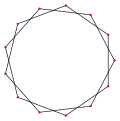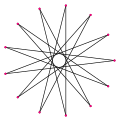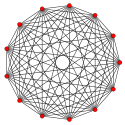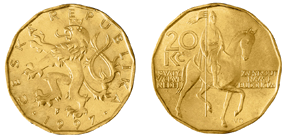| Regular tridecagon | |
|---|---|
 A regular tridecagon | |
| Type | Regular polygon |
| Edges and vertices | 13 |
| Schläfli symbol | {13} |
| Coxeter–Dynkin diagrams | |
| Symmetry group | Dihedral (D13), order 2×13 |
| Internal angle (degrees) | ≈152.308° |
| Properties | Convex, cyclic, equilateral, isogonal, isotoxal |
| Dual polygon | Self |
In geometry, a tridecagon or triskaidecagon or 13-gon is a thirteen-sided polygon.
YouTube Encyclopedic
-
1/5Views:4 40920 9775226 969760
-
Drawing of an approximated tridecagon inscribed in a circle
-
Constructing a tridecagon (triskaidecagon) in a circumcircle with ruler and compass
-
an exact construction of a regular tridecagon
-
Constructing a pentadecagon(15-sided polygon) inside a circle (Step-by-Step drawing 15-gon)
-
Our first tridecagon coin! Say that fast three times!
Transcription
Regular tridecagon
A regular tridecagon is represented by Schläfli symbol {13}.
The measure of each internal angle of a regular tridecagon is approximately 152.308 degrees, and the area with side length a is given by
Construction
As 13 is a Pierpont prime but not a Fermat prime, the regular tridecagon cannot be constructed using a compass and straightedge. However, it is constructible using neusis, or an angle trisector.
The following is an animation from a neusis construction of a regular tridecagon with radius of circumcircle according to Andrew M. Gleason,[1] based on the angle trisection by means of the Tomahawk (light blue).

angle trisection by means of the Tomahawk (light blue). This construction is derived from the following equation:
An approximate construction of a regular tridecagon using straightedge and compass is shown here.

Another possible animation of an approximate construction, also possible with using straightedge and compass.

Based on the unit circle r = 1 [unit of length]
- Constructed side length in GeoGebra
- Side length of the tridecagon
- Absolute error of the constructed side length:
- Up to the maximum precision of 15 decimal places, the absolute error is
- Constructed central angle of the tridecagon in GeoGebra (display significant 13 decimal places, rounded)
- Central angle of tridecagon
- Absolute angular error of the constructed central angle:
- Up to 13 decimal places, the absolute error is
Example to illustrate the error
At a circumscribed circle of radius r = 1 billion km (a distance which would take light approximately 55 minutes to travel), the absolute error on the side length constructed would be less than 1 mm.
Symmetry

The regular tridecagon has Dih13 symmetry, order 26. Since 13 is a prime number there is one subgroup with dihedral symmetry: Dih1, and 2 cyclic group symmetries: Z13, and Z1.
These 4 symmetries can be seen in 4 distinct symmetries on the tridecagon. John Conway labels these by a letter and group order.[2] Full symmetry of the regular form is r26 and no symmetry is labeled a1. The dihedral symmetries are divided depending on whether they pass through vertices (d for diagonal) or edges (p for perpendiculars), and i when reflection lines path through both edges and vertices. Cyclic symmetries in the middle column are labeled as g for their central gyration orders.
Each subgroup symmetry allows one or more degrees of freedom for irregular forms. Only the g13 subgroup has no degrees of freedom but can be seen as directed edges.
Numismatic use
The regular tridecagon is used as the shape of the Czech 20 korun coin.[3]
Related polygons
A tridecagram is a 13-sided star polygon. There are 5 regular forms given by Schläfli symbols: {13/2}, {13/3}, {13/4}, {13/5}, and {13/6}. Since 13 is prime, none of the tridecagrams are compound figures.
| Tridecagrams | |||||||||||
|---|---|---|---|---|---|---|---|---|---|---|---|
| Picture |  {13/2} |
 {13/3} |
 {13/4} |
 {13/5} |
 {13/6} | ||||||
| Internal angle | ≈124.615° | ≈96.9231° | ≈69.2308° | ≈41.5385° | ≈13.8462° | ||||||
Petrie polygons
The regular tridecagon is the Petrie polygon 12-simplex:
| A12 |
|---|
 12-simplex |
References
- ^ Gleason, Andrew Mattei (March 1988). "Angle trisection, the heptagon, and the triskaidecagon p. 192–194 (p. 193 Fig.4)" (PDF). The American Mathematical Monthly. 95 (3): 186–194. doi:10.2307/2323624. Archived from the original (PDF) on 2015-12-19. Retrieved 24 December 2015.
- ^ John H. Conway, Heidi Burgiel, Chaim Goodman-Strauss, (2008) The Symmetries of Things, ISBN 978-1-56881-220-5 (Chapter 20, Generalized Schaefli symbols, Types of symmetry of a polygon pp. 275–278)
- ^ Colin R. Bruce, II, George Cuhaj, and Thomas Michael, 2007 Standard Catalog of World Coins, Krause Publications, 2006, ISBN 0896894290, p. 81.





![{\displaystyle a=0.478631328575115\;[{\text{unit of length}}]}](https://wikimedia.org/api/rest_v1/media/math/render/svg/01ffad01ba0e99b660173a8b6e64d61cffd021ab)
![{\displaystyle a_{\text{target}}=r\cdot 2\cdot \sin \left({\frac {180^{\circ }}{13}}\right)=0.478631328575115\ldots \;[{\text{unit of length}}]}](https://wikimedia.org/api/rest_v1/media/math/render/svg/500fba8371fa117371444c177824170f9028fd5e)
![{\displaystyle F_{a}=a-a_{\text{target}}=0.0\;[{\text{unit of length}}]}](https://wikimedia.org/api/rest_v1/media/math/render/svg/05699992e80898eef00dd40284f70af6e884d118)



